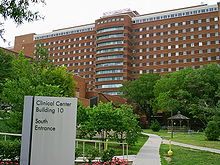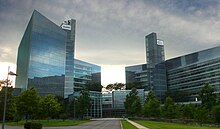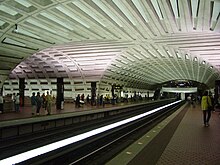Washington metropolitan area
Washington – Arlington – Alexandria | |
|---|---|
 Washington D.C. | |
 Arlington, Virginia | |
 Alexandria, Virginia | |
| Country | |
| State | - - - |
| Principal cities | Washington - Arlington - Alexandria |
| Area | |
| • Metro | 14,412 km2 (5,564.6 sq mi) |
| Elevation | 0 - N/A m (0 - N/A ft) |
| Population (2007 est.)[1] | |
| • Density | 371.8/km2 (962.9/sq mi) |
| • Urban | 3,933,920(4th) |
| • MSA | 5,358,130 (8th) |
| MSA/CSA = 2008, Urban = 2000 | |
| Time zone | UTC-6 (EST) |
| • Summer (DST) | UTC-5 (EST) |
The Washington Metropolitan Area, formally known as the Washington–Arlington–Alexandria, DC–VA–MD–WV MSA, is a U.S. Metropolitan Statistical Area (MSA) defined by the United States Office of Management and Budget. It is also part of the larger Baltimore-Washington Metropolitan Area, the fourth-largest combined statistical area in the United States.
The Washington Metropolitan Area is the most educated and affluent metropolitan area in the United States.[2] As of the 2008 Census Bureau estimate[update], the population of the Washington Metropolitan Area was estimated to be 5,358,130, making it the ninth-largest metropolitan area in the country.[3]
Some federal agencies, such as the Department of Homeland Security, refer to part of the area as the National Capital Region.[4] The Virginia portion of the area is known as Northern Virginia.
Composition



The Washington Metropolitan Area includes the District of Columbia and parts of the states of Maryland, Virginia, and West Virginia. It is divided into two metropolitan divisions:
- the Washington–Arlington–Alexandria, DC–VA–MD–WV Metropolitan Division, comprising the majority of the metropolitan area, and
- the Bethesda–Gaithersburg–Frederick, MD Metropolitan Division, consisting of Montgomery and Frederick counties.
Political subdivisions
The area includes the following counties, districts, and independent cities:
District of Columbia
Maryland
The following counties are categorized as part of the Washington–Arlington–Alexandria, DC–VA–MD–WV Metropolitan Statistical Area:
Though associated with the Washington Metropolitan Area, the following counties are categorized as part of the Baltimore-Towson, MD Metropolitan Statistical Area:
Though associated with the Washington Metropolitan Area, the following county is categorized as part of the Lexington Park, MD Micropolitan Statistical Area:
Virginia
Counties
- Arlington County
- Clarke County
- Fairfax County
- Fauquier County
- Loudoun County
- Prince William County
- Spotsylvania County
- Stafford County
- Warren County
- City of Alexandria
- City of Fairfax
- City of Falls Church
- City of Fredericksburg
- City of Manassas
- City of Manassas Park
West Virginia
Regional organizations
Metropolitan Washington Council of Governments
Founded in 1957, the Metropolitan Washington Council of Governments (MWCOG) is a regional organization of 21 Washington-area local governments, as well as area members of the Maryland and Virginia state legislatures, the U.S. Senate, and the U.S. House of Representatives. MWCOG provides a forum for discussion and the development of regional responses to issues regarding the environment, transportation, public safety, homeland security, affordable housing, community planning, and economic development.[5]
The National Capital Region Transportation Planning Board, a component of MWCOG, is the federally-designated metropolitan planning organization for the metropolitan Washington area.[6]
Principal cities


The metropolitan area includes the following principal cities (most of which are not incorporated as cities; one, Arlington, is actually a county):
- Washington, D.C.
- Arlington, Virginia
- Alexandria, Virginia
- Bethesda, Maryland
- Bowie, Maryland
- Centreville, Virginia
- College Park, Maryland
- Fairfax, Virginia
- Falls Church, Virginia
- Frederick, Maryland
- Gaithersburg, Maryland
- Germantown, Maryland
- Herndon, Virginia
- Leesburg, Virginia
- Manassas, Virginia
- Reston, Virginia
- Rockville, Maryland
- Silver Spring, Maryland
- Suitland, Maryland
- Takoma Park, Maryland
- Tysons Corner, Virginia
- Vienna, Virginia
- Waldorf, Maryland
Demographics
| Year | DEM | GOP | Others |
|---|---|---|---|
| 2008 | 68.0% 1,603,902 | 31.0% 728,916 | 1.0% 25,288 |
| 2004 | 61.0% 1,258,743 | 38.0% 785,144 | 1.4% 19,735 |
| 2000 | 58.5% 1,023,089 | 37.9% 663,590 | 3.6% 62,437 |
| 1996 | 57.0% 861,881 | 37.0% 558,830 | 6.0% 89,259 |
| 1992 | 53.0% 859,889 | 34.1% 553.369 | 12.9% 209,651 |
| 1988 | 50.4% 684,453 | 48.6% 659,344 | 1.0% 14,219 |
| 1984 | 51.0% 653,568 | 48.5% 621,377 | 0.4% 5,656 |
| 1980 | 44.7% 484,590 | 44.6% 482,506 | 11.1% 115,797 |
| 1976 | 54.2% 590,481 | 44.9% 488,995 | 1.0% 10,654 |
| 1972 | 44.2% 431,257 | 54.8% 534,235 | 1.1% 10,825 |
| 1968 | 49.4% 414,345 | 39.1% 327,662 | 11.5% 96,701 |
| 1964 | 69.8% 495,490 | 30.2% 214,293 | 0.1% 462 |
| 1960 | 52.5% 204,614 | 47.3% 184,499 | 0.1% 593 |
Politics
The relative strength of the major political parties within the region is shown by the presidential election results since 1960, as presented in the table to the right.[citation needed]
Racial composition
The area has been a magnet for international in-migration since the late 1960s. It is also a magnet for internal migration (persons moving from one region of the U.S. to another).[7][dubious ] Census estimates show that persons of post-1965 immigrant stock will likely represent 25% of the region's population by 2010, forming a bigger population bloc than native blacks for the first time.[8]
Racial composition of the Washington, D.C. area:[9]
- 2006
- 1980
- White : 67.8%
- Black : 26.0%
- Asian : 2.5%
- Hispanic : 2.8%
- Mixed and Other : 0.9%
Educational attainment and affluence
As of the 2006–2008 American Community Survey, the three most educated places with 200,000 people or more in Washington–Arlington–Alexandria by bachelor's degree attainment (population 25 and over) are Arlington, Virginia (68.0%), Fairfax County, Virginia (58.8%), and Montgomery County, Maryland (56.4%).[10] Forbes magazine stated in its 2008 "America's Best- And Worst-Educated Cities" report: "The D.C. area is less than half the size of L.A., but both cities have around 100,000 Ph.D.'s."[11]
The median household income of the region is $72,800. The two highest median household income counties in the nation – Loudoun and Fairfax County, Virginia – are components of the MSA. 12.2% of Northern Virginia's 881,136 households, 8.5% of suburban Maryland's 799,300 households, and 8.2% of Washington's 249,805 households have an annual income in excess of $200,000, compared to 3.7% nationally.[12]
Economy



The various agencies of the Federal Government employ over 140,000 professionals in the Washington D.C. area. A sizable number in the Washington D.C. area work for defense and civilian contracting companies that conduct business directly with the Federal Government (many of these firms are referred to as 'Beltway Bandits' under the local vernacular). As a result, the Federal Government provides the underlying basis of the economy in the region. However, the Washington D.C. area is increasingly home to a diverse segment of businesses not directly related to the Federal Government.
The Washington, D.C. area was ranked as the second best High-Tech Center in a satistical analysis of the top 100 Metropolitan areas in the United States by American City Business Journals in May 2009, behind the greater San Jose area and, ahead of the Boston Area. <http://www.bizjournals.com/specials/pages/251.html> Fueling the Washinton D.C. areas ranking was the reported 241,264 science & engineering jobs in the region. This total was eclipsed only by New York, Los Angeles and the combined San Jose-San Francisco-Oakland regions.
Notably the Washington D.C. Area is home to several major research universities, hundreds of think tanks and non-profit organizations. Additionally, Washington D.C. is a top tourism destination as flocks of Americans and foreigners from around the world visit the museums and monuments of the Capital city year round with the peak season being during the Spring and Summer months of April through August. Moreover, the Washington D.C. area attracts dozens of major conferences & conventions each year which also contribute greatly to the region's economy.
Primary industries
Biotechnology
Not limited to its proximity to the National Institutes of Health, Maryland's Washington suburbs are a major center for biotechnology. Prominent local biotech companies include MedImmune, The Institute for Genomic Research, Human Genome Sciences, and the Howard Hughes Medical Institute.
Defense contracting
Many defense contractors are based in the region to be close to the Pentagon in Arlington. Local defense contractors include Lockheed Martin, the largest, as well as Raytheon, General Dynamics, BAE Systems, Computer Sciences Corporation (CSC), Science Applications International Corporation (SAIC), CACI, and Orbital Sciences Corporation.
Notable company headquarters in the region
(Numbers denote Fortune 500 company ranking.)
Washington, D.C.
- Black Entertainment Television
- Bureau of National Affairs
- Calibre Energy
- Carlyle Group
- Danaher Corporation 213
- Fannie Mae 112
- National Geographic Society
- Pepco Holdings 254
- The Washington Post Company
- XM Satellite Radio
Suburban Maryland
- BAE Systems Inc. (Rockville)
- Bethesda Softworks (Rockville)
- Chevy Chase Bank (Bethesda)
- Choice Hotels (Silver Spring)
- Coventry Health Care (Bethesda) 226
- Discovery Communications (Silver Spring)
- GEICO (Chevy Chase)
- Host Hotels & Resorts (Bethesda) 449
- Hughes Network Systems (Germantown)
- Lockheed Martin (Bethesda) 54
- Marriott International (Bethesda) 208
- MedImmune (Gaithersburg)
- Radio One (Lanham)
- Ritz-Carlton (Chevy Chase)
- TV One (Silver Spring)
Northern Virginia
- AES Corporation (Arlington) 158
- Airbus North America (Herndon)
- BearingPoint (McLean)
- Booz Allen Hamilton (McLean)
- CACI (Arlington)
- Capital One (McLean) 145
- Computer Sciences Corporation (Falls Church) 153
- DynCorp International (Falls Church)
- Freddie Mac (McLean) 220
- FNH USA (Fredericksburg)
- Gannett Company (McLean) 371
- General Dynamics (Falls Church) 83
- Hilton Hotels Corporation (McLean)
- Kellogg Brown and Root Services (Arlington)
- Mars, Incorporated (McLean)
- Navy Federal Credit Union (Vienna)
- NII Holdings(Reston)
- NVR Incorporated (Reston) 464
- Orbital Sciences (Dulles)
- Rolls-Royce North America (Reston)
- Science Applications International Corporation (McLean) 266
- Space Adventures (Vienna)
- SLM Corporation (Reston) "Sallie Mae" 331
- USA Today (McLean)
- Verizon Business (Ashburn)
- Volkswagen Group of America (Herndon)
- XO Communications (Herndon)
Transportation


Major airports
- Washington Dulles International Airport (IAD), located in Chantilly, Virginia – the busiest in the region
- Ronald Reagan Washington National Airport (DCA), located in Arlington County, Virginia – the closest to Washington
- Baltimore-Washington International Thurgood Marshall Airport (BWI), located in Linthicum, Maryland – in the Baltimore Metropolitan Area
Rail transit systems
- Washington Metro – DC, MD, VA
- MARC Train – DC, MD, WV
- Virginia Railway Express – DC, VA
- Amtrak – DC, MD, VA, WV
Bus transit systems
- Ride On (bus) - Montgomery County, Maryland
- TheBus - Prince George's County, Maryland
- Metrobus – DC, MD, VA
- DC Circulator – DC
- ART - Arlington County, VA
- Fairfax Connector - Fairfax County, Virginia
- DASH (bus) - Alexandria, Virginia
See also
- List of federal agencies in Northern Virginia
- List of federal installations in Maryland
- List of people from the Washington, D.C. metropolitan area
- List of U.S. Metropolitan Statistical Areas in Virginia
- Potomac primary
References
- ^ "Annual Estimates of the Population of Metropolitan and Micropolitan Statistical Areas: April 1, 2000 to July 1, 2008". US Census Bureau. Retrieved March 22, 2009.
- ^ Washington area richest, most educated in US: report
- ^ Annual Estimates of the Population of Metropolitan and Micropolitan Statistical Areas: April 1, 2000 to July 1, 2008
- ^ "National Capital Region – Office of National Capital Region Coordination". Department of Homeland Security. December 21, 2005. Retrieved 2008-01-09.
- ^ http://www.mwcog.org/about/
- ^ http://www.mwcog.org/transportation/tpb/
- ^ http://www.psc.isr.umich.edu/pubs/pdf/rr02-496.pdf "Metro Magnets for Minorities and Whites: Melting Pots, the New Sunbelt, and the Heartland", Pages 9 and 10
- ^ http://www.census.gov/popest/counties/asrh/CC-EST2007-alldata.html
- ^ http://census.gov/popest/counties/asrh/CC-EST2006-RACE6.html
- ^ 2006–2008 American Community Survey 3-Year Estimates
- ^ America's Best- And Worst-Educated Cities
- ^ ACS 2005-2007
- ^ High-Rises Approved That Would Dwarf D.C.
- ^ List of tallest buildings in DC, MD, VA, WV
External links
- OMB Bulletin No. 05-02
- Urban Areas of Virginia
- May 2006 Metropolitan and Nonmetropolitan Area Occupational Employment and Wage Estimates; Washington-Arlington-Alexandria, DC-VA-MD-WV Metropolitan Division
- May 2005 Metropolitan Area Occupational Employment and Wage Estimates; Washington-Arlington-Alexandria, DC-VA-MD-WV Metropolitan Division
- Washington-Arlington-Alexandria, DC-VA-MD-WV MSA Population and Components of Change
